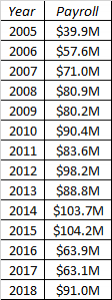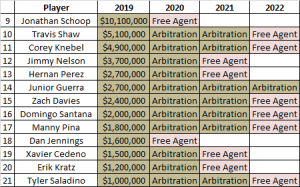After a busy day of arbitration decisions, it’s worth taking stock of some recent developments in the broader market. We’ve already touched upon some major storylines today, with looks at Patrick Corbin (link), Zack Greinke (link), and Carlos Carrasco (link). Here’s more …
- Though Corbin seems to be captivating the market at present, chatter on Nathan Eovaldi is also “heating up,” per MLB.com’s Mark Feinsand (Twitter link). Unsurprisingly, the Red Sox and Astros are presently seen as prime contenders to land him. With the American League shaping up to be another clash of titans, those organizations are positioned t stake some dough on Eovaldi’s upside.
- The Yankees are a major player on Corbin, of course, but also some other arms — and not just as a backup plan. Indeed, per Jayson Stark of The Athletic (via Twitter), the club could even add another significant starter if it does get Corbin. That’d be quite a surprise, given that the team would appear to have a clear starting five if Corbin signs, but perhaps there’s a way to pull something off that would still make sense and leave the club with immense rotation depth.
- Meanwhile, southpaw J.A. Happ is said to have “ten teams chasing” him at this point, per Jon Heyman of Fancred. One of those is the Brewers, who’d presumably like to bolster their rotation but also don’t appear to have an immense amount of money to use. Of course, giving up on Jonathan Schoop clears a big piece of payroll, so long as the club finds a way to address its infield needs without using all the savings.
- There’s also a “strong” market for Japanese hurler Yusei Kikuchi, Heyman tweets. Unsurprisingly, west coast clubs — the Dodgers, Padres, Giants, and Mariners, at least — appear to be lining up for the 27-year-old. It’s still hard to know what kind of salary and duration he’ll be able to command. But as this particular list of clubs shows, Kikuchi’s unusual youth will play a major role in his market by opening the door to quite a few organizations to pursue him.
- Elsewhere, the Yankees are still trying to offload an asset in Sonny Gray. Per Ken Davidoff of the New York Post, with GM Brian Cashman saying he has discussed a multitude of different scenarios involving Gray, including some larger deals. That suggests that the Yanks are comfortable hanging onto Gray for a while as they sort through the possibilities, rather than putting him on the market and taking the best deal then available.
- Gray is as good as gone from the team’s perspective, but that’s clearly not the same situation for Giants ace Madison Bumgarner. The burly southpaw is reportedly on the table. But that doesn’t mean he’ll be priced at a level that will lead to a deal. Indeed one organizational source tells Heyman (Twitter link) they “don’t see [Bumgarner] going anywhere this winter.” Certainly, the Giants have little need to dump Bumgarner if they aren’t getting something worthwhile in return. Teams with interest, though, will remain wary of a big price for one season of a player with recent shoulder woes and some performance questions.



